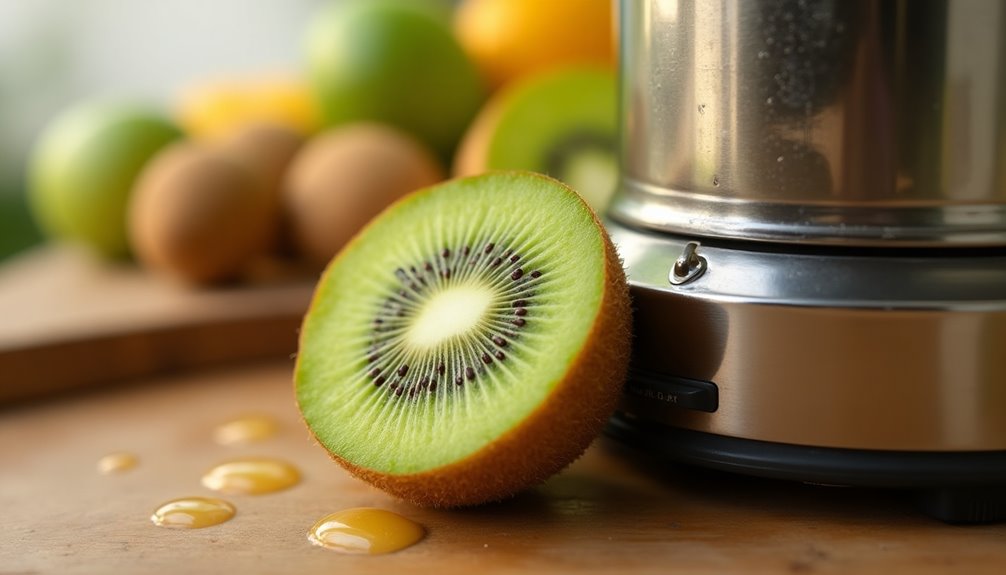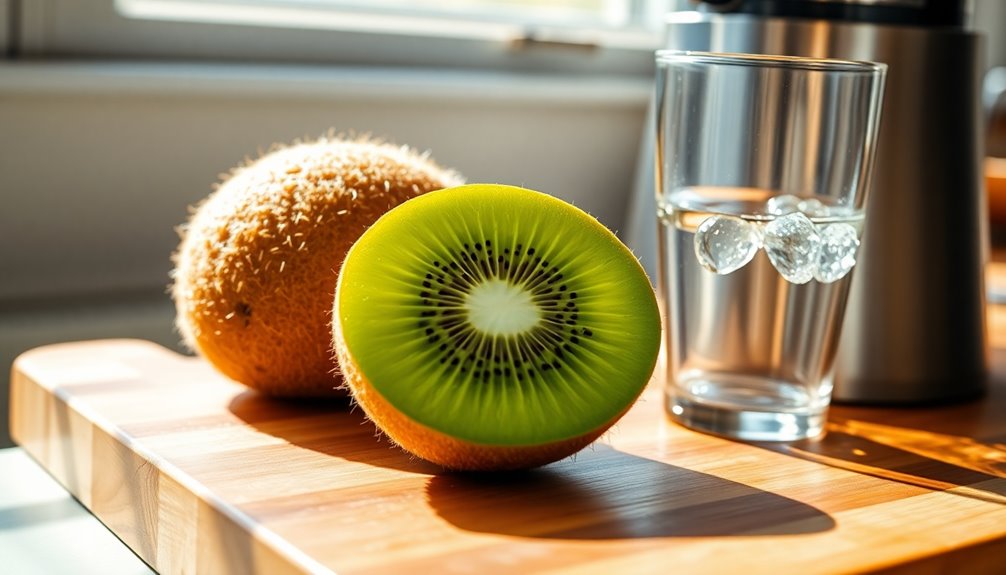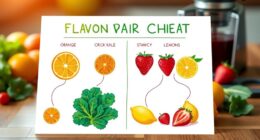To juice a kiwi, start by washing them thoroughly and cutting off the tops and bottoms. You can either use a juicer or blend them with a hand-held blender, then strain the mixture through a nut milk bag for smooth juice. If you want to enhance the flavor, mix in other fruits or add a sweetener like honey. Don’t forget to adjust the consistency with water if needed. Discover more tips for perfecting your kiwi juice! For a refreshing twist, consider adding a splash of citrus, such as lime or lemon juice, to your kiwi juice for a zesty kick. As you explore different kiwi juice recipe steps, feel free to experiment with herbs like mint or basil, which can elevate the drink’s flavor profile. Remember to chill the juice before serving, as a cold beverage can enhance the overall taste and experience.
Key Takeaways
- Wash kiwis thoroughly and decide whether to keep the skin on for added fiber or peel it for a smoother texture.
- Cut kiwis into smaller pieces that fit your juicer's chute, or blend them with a hand-held blender for a homemade option.
- Strain the blended mixture through a nut milk bag to separate the juice from the pulp, aiming for a pulp-free juice.
- Enhance flavor by blending kiwis with other fruits or greens, and adjust sweetness with natural sweeteners like honey or maple syrup.
- Consume fresh kiwi juice within 24 hours for optimal flavor, or store in the refrigerator for up to three days.

Juicing a kiwi is a simple way to enjoy its vibrant flavor and health benefits. This tiny fruit is packed with vitamin C and offers a unique sweet-tart taste that can elevate your homemade kiwi juice to a whole new level. Getting started is easy, and with just a few steps, you'll have a refreshing drink that's perfect for any occasion.
First, wash your kiwis thoroughly to remove any dirt or residue. You can leave the skin on for added fiber, but if you prefer a smoother texture, cut off the tops and bottoms and peel the skin away. This choice is entirely up to you and your taste preferences.
Once you've prepared the kiwis, you can choose how to juice them. If you have a juicer, simply cut the kiwis into pieces that fit the chute, and let the machine do the work for you. For those without a juicer, don't worry—you can also use a hand-held blender. Just blend the kiwis until smooth, then strain the mixture through a nut milk bag to separate the juice from the pulp, leaving you with a delicious, pulp-free kiwi juice.
Want to enhance the flavor and nutrition of your homemade kiwi juice? You can easily create a unique recipe by blending kiwis with other fruits like apples or strawberries. These combinations not only taste great but also pack in additional vitamins and minerals. If you're feeling adventurous, consider adding some greens like spinach or kale for a nutrient boost. The sweetness of the kiwi pairs well with these ingredients, creating a refreshing blend that's both delicious and healthy.
Once you've made your kiwi juice, you might find it's a bit thick for your liking. No problem! You can dilute it with water or coconut water to reach your desired consistency. If you want to sweeten your drink, natural sweeteners like honey or maple syrup work beautifully. Just remember to taste as you go, so you can balance the flavors to your preference.
For the best experience, consume your fresh kiwi juice within 24 hours. This ensures you get the most vibrant flavor and maximum nutrients. If you can't finish it right away, you can store it in the refrigerator for up to three days. Simply pour any leftovers into ice-cube trays and freeze them for longer storage. These frozen kiwi juice cubes can add a refreshing twist to smoothies or can be enjoyed on their own as a healthy treat.
In no time, you'll be enjoying your homemade kiwi juice, bursting with flavor and packed with health benefits. So grab some kiwis, and start juicing! You'll love the refreshing taste and the boost of vitamin C. Additionally, the antioxidant properties of kiwi juice may help combat skin aging, making it a great addition to your skincare regimen.
Frequently Asked Questions
Do You Have to Peel Kiwi Before Juicing?
You don't have to peel kiwi before juicing, but it's up to you. The skin's edible and packed with nutrients, so you can scrub it clean and keep that fiber.
If you want a smoother texture, peeling might be the way to go. Remember to cut off the hard stem tops, regardless of whether you peel or not.
Also, overripe kiwis might taste better without the skin due to potential bitterness.
Are Kiwis Good for Juicing?
Yes, kiwis are fantastic for juicing!
They're packed with vitamin C, offering more than double the daily recommended intake in just one serving. Their natural sweetness and tangy flavor create a refreshing juice that complements other fruits and veggies perfectly.
Plus, with only about 50 calories per serving, it's a healthy choice. The antioxidants and dietary fiber in kiwis also support your overall health and digestion, making kiwi juice a smart addition to your diet!
Can You Blend an Entire Kiwi?
You might think blending a kiwi whole is a quirky idea, but it's actually a delightful way to capture all its vibrant goodness.
Yes, you can blend an entire kiwi, skin and all, for a nutrient-packed treat. Just remember to use a high-powered blender to ensure a smooth consistency.
Cutting off the tough stem tops helps too. Enjoy the flavor and texture, and don't shy away from that delightful pulp!
Can You Soak Kiwi in Water?
You can soak kiwi in water, but it's not the best idea. Soaking can lead to nutrient loss, especially water-soluble vitamins like vitamin C.
If you must soak them for cleaning, keep it brief—just a few minutes. Prolonged soaking can make the kiwi mushy and alter its flavor.
Instead, rinsing under running water is a better method to remove dirt and pesticides while preserving the fruit's nutrients and taste.
Conclusion
Juicing a kiwi is as refreshing as a summer breeze, bringing vibrant flavor to your glass. You've learned the simple steps to transform this fuzzy fruit into a delicious juice, packed with nutrients. So, grab your kiwis and let your creativity flow—mix them with other fruits or enjoy them solo. Each sip will be a burst of sunshine, reminding you that healthy choices can be deliciously fun. Cheers to your newfound kiwi juicing adventure!
Cindy thoroughly researches juicing trends, techniques, and recipes to provide readers with practical advice and inspiration. Her writing style is accessible, engaging, and designed to make complex concepts easy to understand. Cindy’s dedication to promoting the advantages of juicing shines through her work, empowering readers to make positive changes in their lives through the simple act of juicing.











